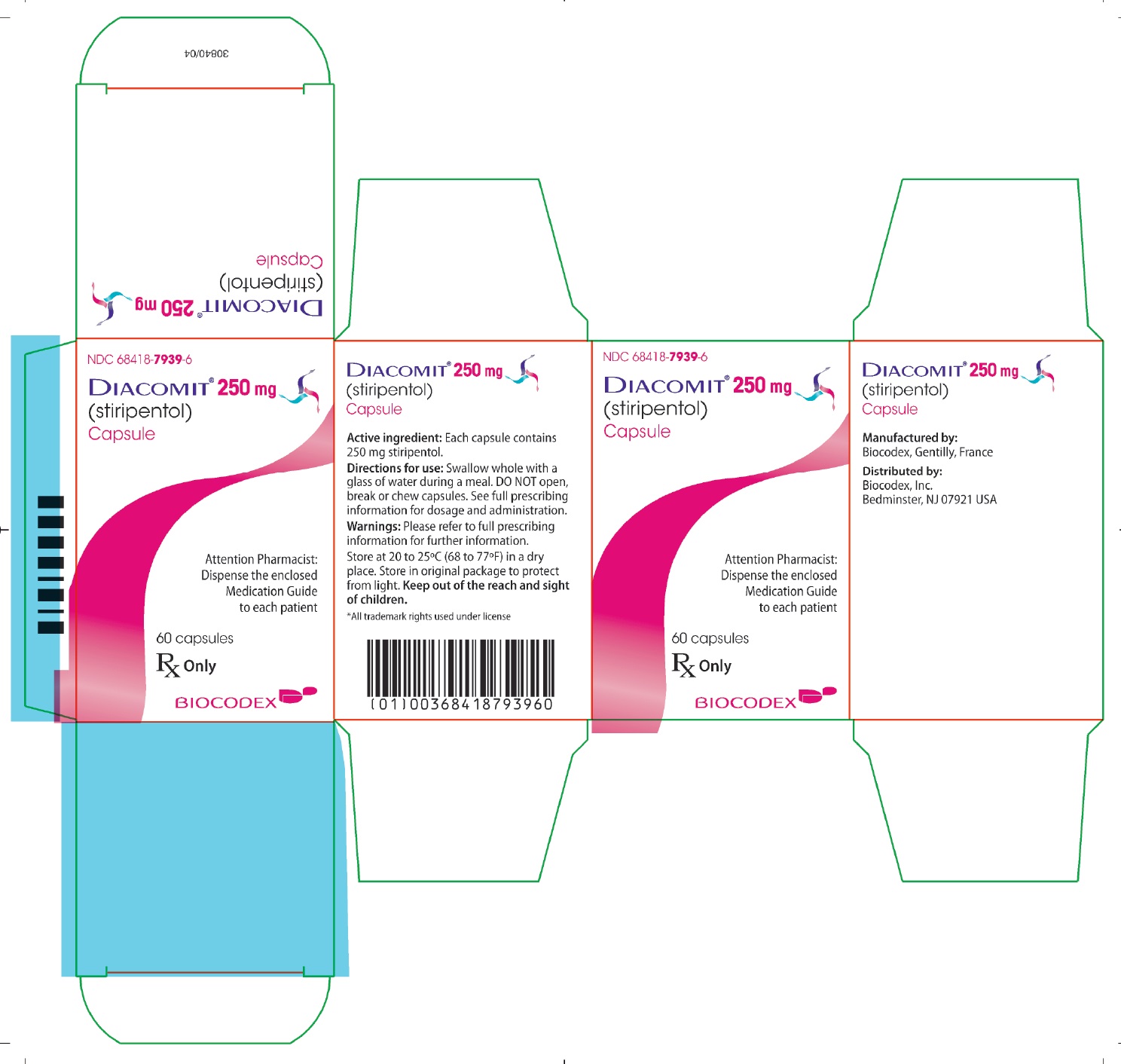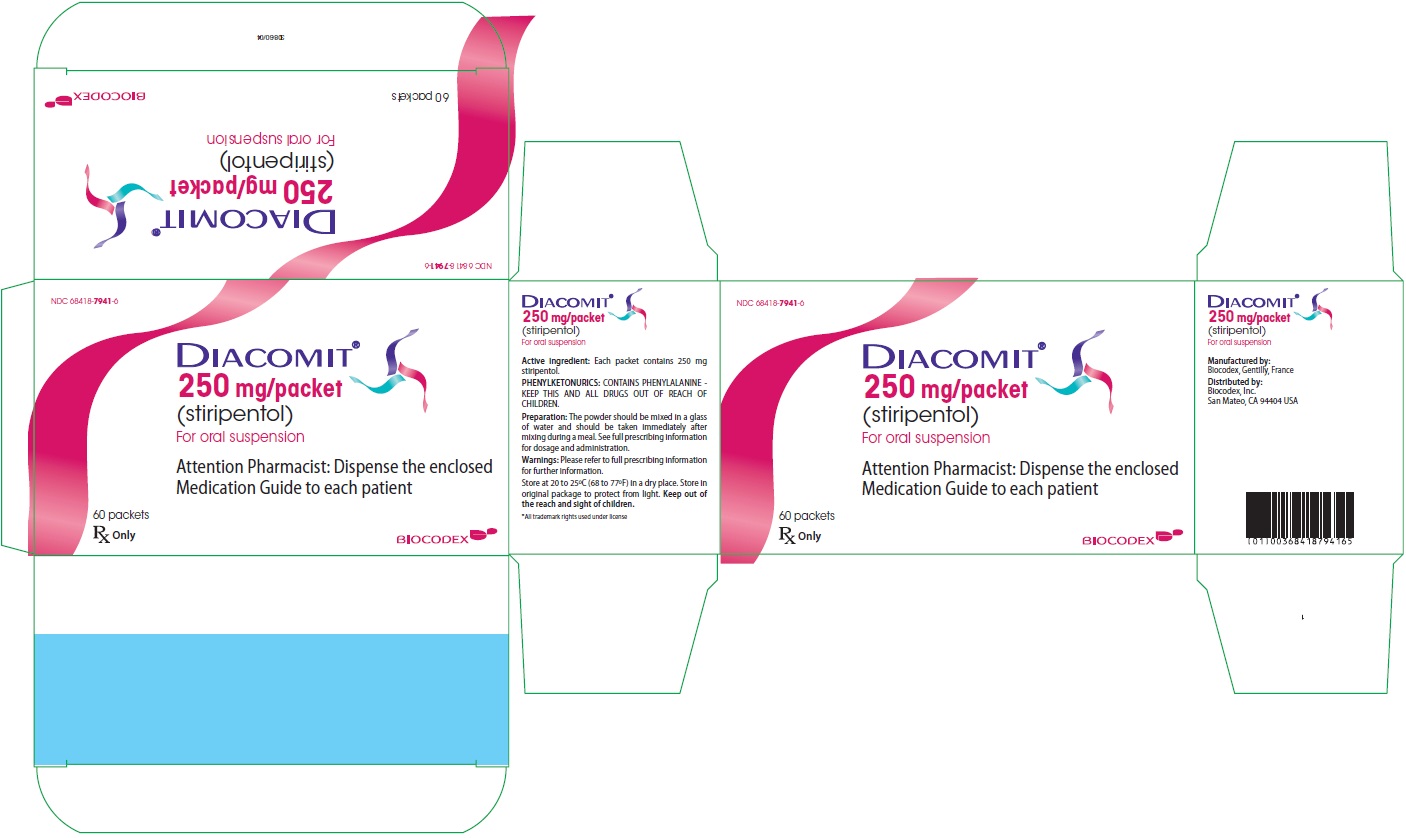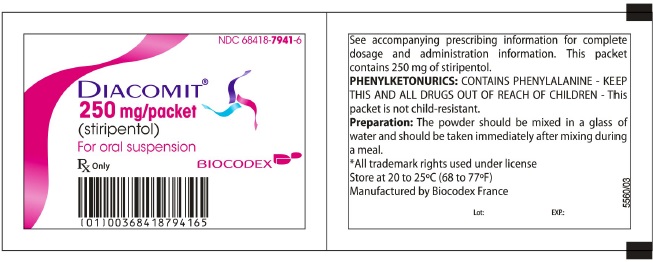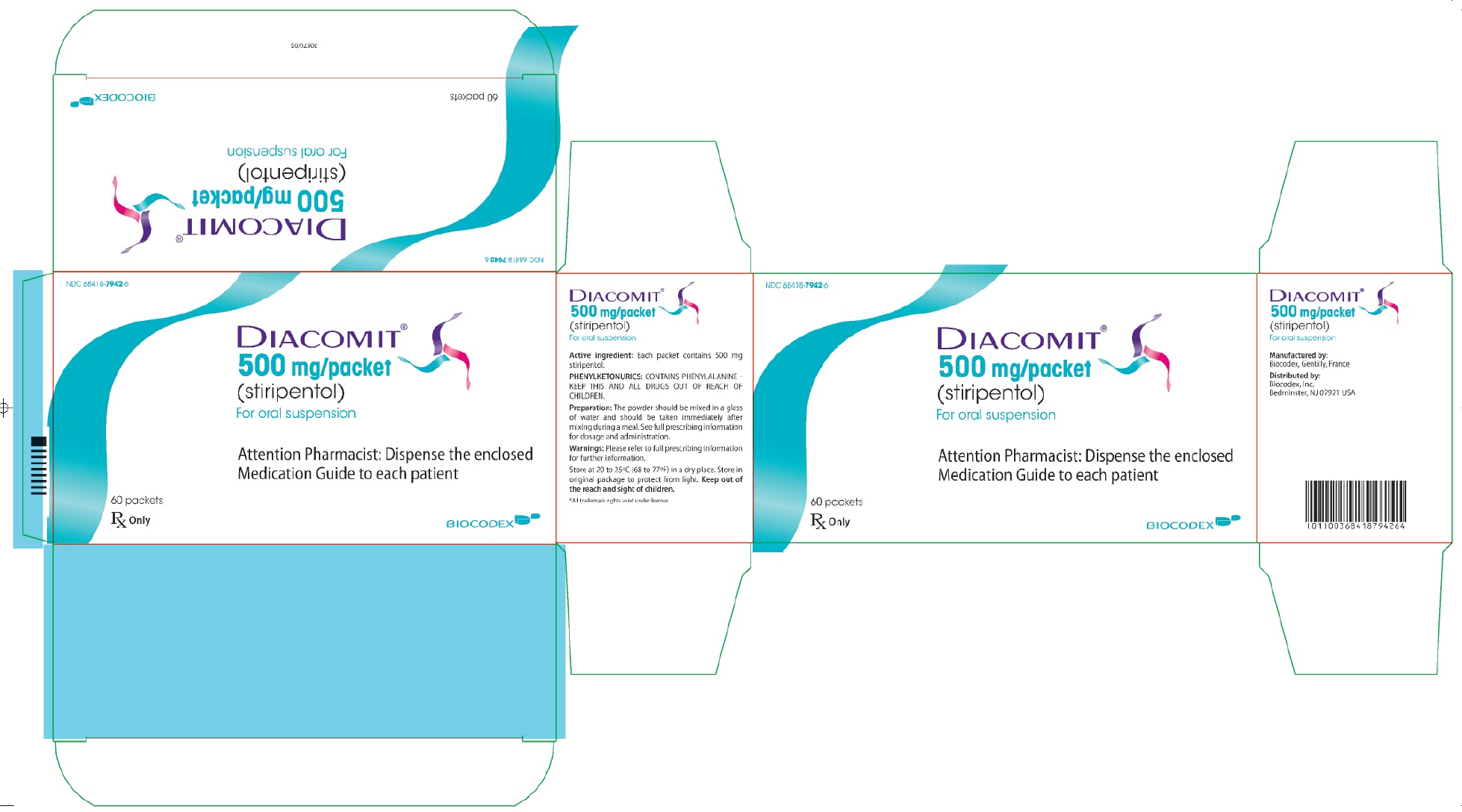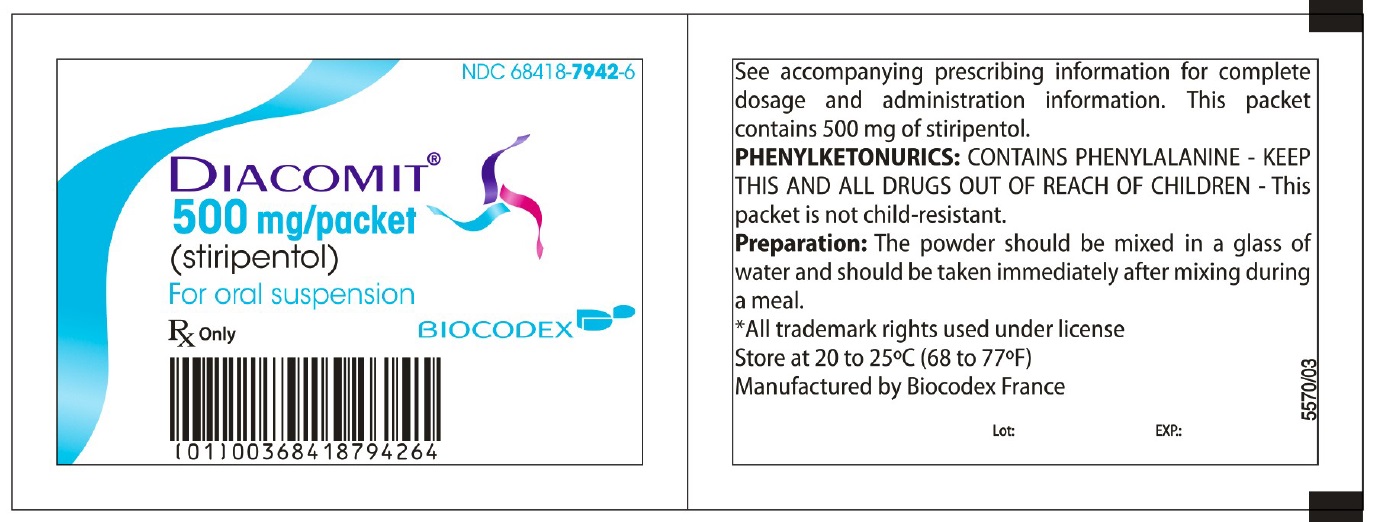Label: DIACOMIT- stiripentol capsule
DIACOMIT- stiripentol powder, for suspension
-
Contains inactivated NDC Code(s)
NDC Code(s): 68418-7939-6, 68418-7940-6, 68418-7941-6, 68418-7942-6 - Packager: BIOCODEX, INC.
- Category: HUMAN PRESCRIPTION DRUG LABEL
- DEA Schedule: None
- Marketing Status: New Drug Application
Drug Label Information
Updated July 24, 2022
If you are a consumer or patient please visit this version.
- Download DRUG LABEL INFO: PDF XML
- Medication Guide: HTML
- Official Label (Printer Friendly)
-
HIGHLIGHTS OF PRESCRIBING INFORMATION
These highlights do not include all the information needed to use DIACOMIT safely and effectively.
See full prescribing information for DIACOMIT.
DIACOMIT (stiripentol) capsules, for oral use
DIACOMIT (stiripentol) for oral suspension
Initial U.S. Approval: 2018INDICATIONS AND USAGE
DIACOMIT is indicated for the treatment of seizures associated with Dravet syndrome in patients taking clobazam who are 6 months of age and older and weighing 7 kg or more . There are no clinical data to support the use of DIACOMIT as monotherapy in Dravet syndrome. (1)
DOSAGE AND ADMINISTRATION
- The dosage of DIACOMIT is 50 mg/kg/day, administered by mouth in 2 or 3 divided doses, depending on age and weight. (2.2)
- Capsules must be swallowed whole with a glass of water during a meal. Capsules should not be broken or opened. (2.3)
- Powder for suspension should be mixed in a glass of water and should be taken immediately after mixing during a meal. (2.3)
- Reduce dose or discontinue dose gradually. (2.5)
CONTRAINDICATIONS
None (4)
WARNINGS AND PRECAUTIONS
- Somnolence: Monitor for somnolence, particularly when DIACOMIT is used concomitantly with other CNS depressants; If somnolence occurs during co-administration with clobazam, consider an initial reduction of clobazam by 25%. (5.1)
- Decreased Appetite and Decreased Weight: the weight of patients and the growth rate of pediatric patients should be carefully monitored. (5.2)
- Neutropenia and Thrombocytopenia: Blood counts should be obtained prior to starting treatment with DIACOMIT and then every 6 months. (5.3)
- Withdrawal: DIACOMIT should be gradually withdrawn to minimize the risk of increased seizure frequency and status epilepticus. (5.4)
- Risks in Patients with Phenylketonuria (PKU): DIACOMIT for oral suspension contains phenylalanine; consider total daily intake before prescribing to patients with PKU. (5.5)
- Suicidal Behavior and Ideation: Monitor for suicidal thoughts or behaviors. (5.6)
ADVERSE REACTIONS
Adverse reactions that occurred in at least 10% of DIACOMIT-treated patients and more frequently than on placebo were somnolence, decreased appetite, agitation, ataxia, weight decreased, hypotonia, nausea, tremor, dysarthria, and insomnia. (6.1)
To report SUSPECTED ADVERSE REACTIONS, contact BIOCODEX at 1-866-330-3050 or FDA at 1-800-FDA-1088 or www.fda.gov/medwatch.
DRUG INTERACTIONS
- DIACOMIT increases the plasma concentration of clobazam and its metabolite through metabolic inhibition of CYP3A4 and CYP2C19. Consider dose reduction of clobazam in case of adverse reactions. (7.1)
- Substrates of CYP2C8, CYP2C19, P-gp and BCRP may require a dose reduction. (7.1)
- Substrates of CYP1A2, CYP2B6 and CYP3A4 may require a dose adjustment. (7.1)
- Strong inducers of CYP1A2, CYP3A4 or CYP2C19: Consider dose increase of DIACOMIT. (7.2)
USE IN SPECIFIC POPULATIONS
- Pregnancy: Based on animal data, may cause fetal harm. (8.1)
See 17 for PATIENT COUNSELING INFORMATION and Medication Guide.
Revised: 7/2022
-
Table of Contents
FULL PRESCRIBING INFORMATION: CONTENTS*
1 INDICATIONS AND USAGE
2 DOSAGE AND ADMINISTRATION
2.1 Laboratory Tests Prior to First Dose of DIACOMIT
2.2 Dosing Information
2.3 Important Administration Instructions
2.4 Missed Dose
2.5 Gradual Withdrawal
3 DOSAGE FORMS AND STRENGTHS
4 CONTRAINDICATIONS
5 WARNINGS AND PRECAUTIONS
5.1 Somnolence
5.2 Decreased Appetite and Decreased Weight
5.3 Neutropenia and Thrombocytopenia
5.4 Withdrawal Symptoms
5.5 Risks in Patients with Phenylketonuria
5.6 Suicidal Behavior and Ideation
6 ADVERSE REACTIONS
6.1 Clinical Trials Experience
7 DRUG INTERACTIONS
7.1 Effect of DIACOMIT on Other Drugs
7.2 Effect of Other Drugs on DIACOMIT
7.3 CNS Depressants and Alcohol
8 USE IN SPECIFIC POPULATIONS
8.1 Pregnancy
8.2 Lactation
8.4 Pediatric Use
8.5 Geriatric Use
8.6 Renal Impairment
8.7 Hepatic Impairment
10 OVERDOSAGE
11 DESCRIPTION
12 CLINICAL PHARMACOLOGY
12.1 Mechanism of Action
12.2 Pharmacodynamics
12.3 Pharmacokinetics
13 NONCLINICAL TOXICOLOGY
13.1 Carcinogenesis, Mutagenesis, Impairment of Fertility
14 CLINICAL STUDIES
16 HOW SUPPLIED/STORAGE AND HANDLING
16.1 How Supplied
16.2 Storage and Handling
17 PATIENT COUNSELING INFORMATION
- *
- Sections or subsections omitted from the full prescribing information are not listed.
- 1 INDICATIONS AND USAGE
-
2 DOSAGE AND ADMINISTRATION
2.1 Laboratory Tests Prior to First Dose of DIACOMIT
Hematologic testing should be obtained prior to starting treatment with DIACOMIT [see Warnings and Precautions (5.3)].
2.2 Dosing Information
The recommended oral dosage of DIACOMIT is 50 mg/kg/day, administered in 2 or 3 divided doses (i.e., 16.67 mg/kg three times daily or 25 mg/kg twice daily), depending on the patient’s age and body weight as shown in Table 1. If the exact dosage is not achievable given the available strengths, round to the nearest possible dosage, which is usually within 50 mg to 150 mg of the recommended 50 mg/kg/day. A combination of the two DIACOMIT strengths can be used to achieve this dosage. The maximum recommended total dosage is 3,000 mg/day.
Table 1. Recommended Dosage for Patients 6 Months of Age and Older Weighing 7 kg or More with Dravet Syndrome
Age of Patient
Body Weight
Dosing Regimen
(administered by mouth in equally divided doses)
Total Daily Dose
6 months to less than 1 year
7 kg and above
25 mg/kg twice dailya,b
50 mg/kg/day
1 year and above
7 kg to less than 10 kg
25 mg/kg twice dailyb
50 mg/kg/day
10 kg and above
25 mg/kg twice daily or
16.67 mg/kg three times daily
50 mg/kg/day
Maximum daily dose is 3000 mg
a Dosing frequency should not exceed twice daily to limit free water administration.
b Dosing frequency should not exceed twice daily to avoid overexposures.
2.3 Important Administration Instructions
DIACOMIT Capsules
DIACOMIT capsules must be swallowed whole with a glass of water during a meal. Capsules should not be broken or opened.DIACOMIT for Oral Suspension
DIACOMIT should be mixed in a glass of water (100 mL) and should be taken immediately after mixing during a meal. To be sure there is no medicine left in the glass, add a small amount of water (25 mL) to the drinking cup and drink all of the mixture [see Instructions for Use].2.4 Missed Dose
A missed dose should be taken as soon as possible. If it is almost time for the next dose, the missed dose should not be taken. Instead, the next scheduled dose should be taken. Doses should not be doubled.
2.5 Gradual Withdrawal
As is advisable for most antiepileptic drugs, if DIACOMIT treatment is discontinued, the drug should be withdrawn gradually to minimize the risk of increased seizure frequency and status epilepticus [see Warnings and Precautions (5.4)].
In situations where rapid withdrawal of DIACOMIT is medically required, appropriate monitoring is recommended.
- 3 DOSAGE FORMS AND STRENGTHS
- 4 CONTRAINDICATIONS
-
5 WARNINGS AND PRECAUTIONS
5.1 Somnolence
DIACOMIT can cause somnolence. In controlled studies in patients with Dravet syndrome, the incidence of somnolence was 67% in DIACOMIT-treated patients, compared to 23% in patients on placebo. All patients in both groups were on concomitant clobazam, which is also known to cause somnolence. Co-administration of DIACOMIT with clobazam results in increased levels of clobazam and its active metabolite [see Drug Interactions (7.1)]. Other central nervous system CNS depressants, including alcohol, could potentiate the somnolence effect of DIACOMIT.
Prescribers should monitor patients for somnolence. If somnolence occurs during co-administration with clobazam, consider an initial reduction of clobazam by 25%. If somnolence persists, further clobazam reduction by an additional 25% should be considered, as should adjustment of the dosage of other concomitant anticonvulsant drugs with sedating properties. Prescribers should caution patients against engaging in hazardous activities requiring mental alertness, such as operating dangerous machinery or motor vehicles, until the effect of DIACOMIT on mental alertness is known.
5.2 Decreased Appetite and Decreased Weight
DIACOMIT can cause decreases in appetite and weight. In controlled studies in patients with Dravet syndrome, the incidence of decreased appetite was 46% in DIACOMIT-treated patients, compared to 10% in patients on placebo. The incidence of decreased weight was 27% in DIACOMIT-treated patients, compared to 6% in patients on placebo. Nausea and vomiting also occurred more frequently in DIACOMIT-treated patients [see Adverse Reactions (6.1)]. Given the frequency of these adverse reactions, the growth of pediatric patients treated with DIACOMIT should be carefully monitored. In some cases, decreasing the dose of concomitant valproate by 30% per week can reduce the decrease in appetite and weight.
5.3 Neutropenia and Thrombocytopenia
DIACOMIT can cause a significant decline in neutrophil count. In controlled studies in patients with Dravet syndrome, there were 31 patients treated with DIACOMIT who had both a baseline and end-of-study neutrophil count obtained. A decrease in neutrophil count from normal at baseline to less than 1500 cells/mm3 during the trial was observed in 13% of these DIACOMIT- treated patients, but not in any placebo-treated patients.
DIACOMIT can cause a significant decline in platelet count. In controlled studies in patients with Dravet syndrome, there were 31 patients treated with DIACOMIT who had both a baseline and end-of-study platelet count. A decrease in platelet count from normal at baseline to less than 150,000/µL during the trial was observed in 13% of these DIACOMIT-treated patients, but not in any placebo-treated patients.
Hematologic testing should be obtained prior to starting treatment with DIACOMIT, and then every 6 months.
5.4 Withdrawal Symptoms
As with most antiepileptic drugs, DIACOMIT should generally be withdrawn gradually to minimize the risk of increased seizure frequency and status epilepticus.
In situations where rapid withdrawal of DIACOMIT is required (e.g., in the setting of a serious adverse reaction), appropriate monitoring is recommended.
5.5 Risks in Patients with Phenylketonuria
Phenylalanine can be harmful to patients with phenylketonuria (PKU). DIACOMIT for oral suspension contains phenylalanine, a component of aspartame. Each 250 mg packet contains 1.40 mg phenylalanine; each 500 mg packet contains 2.80 mg phenylalanine. Before prescribing DIACOMIT for oral Suspension to a patient with PKU, consider the combined daily amount of phenylalanine from all sources, including DIACOMIT for oral Suspension.
DIACOMIT capsules do not contain phenylalanine.
5.6 Suicidal Behavior and Ideation
AEDs, including DIACOMIT, increase the risk of suicidal thoughts or behavior in patients taking these drugs for any indication. Patients treated with any AED for any indication should be monitored for the emergence or worsening of depression, suicidal thoughts or behavior, and/or any unusual changes in mood or behavior.
Pooled analyses of 199 placebo-controlled clinical trials (mono- and adjunctive therapy) of 11 different AEDs showed that patients randomized to one of the AEDs had approximately twice the risk (adjusted relative risk 1.8, 95% confidence interval [CI]:1.2, 2.7) of suicidal thinking or behavior compared to patients randomized to placebo. In these trials, which had a median treatment duration of 12 weeks, the estimated incidence rate of suicidal behavior or ideation among 27,863 AED treated patients was 0.43%, compared to 0.24% among 16,029 placebo treated patients, representing an increase of approximately one case of suicidal thinking or behavior for every 530 patients treated. There were four suicides in drug treated patients in the trials and none in placebo treated patients, but the number is too small to allow any conclusion about drug effect on suicide.
The increased risk of suicidal thoughts or behavior with AEDs was observed as early as one week after starting drug treatment with AEDs and persisted for the duration of treatment assessed. Because most trials included in the analysis did not extend beyond 24 weeks, the risk of suicidal thoughts or behavior beyond 24 weeks could not be assessed.
The risk of suicidal thoughts or behavior was generally consistent among drugs in the data analyzed. The finding of increased risk with AEDs of varying mechanisms of action and across a range of indications suggests that the risk applies to all AEDs used for any indication. The risk did not vary substantially by age (5-100 years) in the clinical trials analyzed. Table2 shows absolute and relative risk by indication for all evaluated AEDs.
Table 2. Risk by Indication for Antiepileptic Drugs in the Pooled Analysis Indication Placebo Patients
with Events per
1000 PatientsDrug Patients with
Events per 1000
PatientsRelative Risk:
Incidence of Drug
Events in Drug
Patients/Incidence in
Placebo PatientsRisk Difference:
Additional Drug
Patients with Events
per 1000 PatientsEpilepsy 1.0 3.4 3.5 2.4 Psychiatric 5.7 8.5 1.5 2.9 Other 1.0 1.8 1.9 0.9 Total 2.4 4.3 1.8 1.9 The relative risk for suicidal thoughts or behavior was higher in clinical trials for epilepsy than in clinical trials for psychiatric or other conditions, but the absolute risk differences were similar for the epilepsy and psychiatric indications.
Anyone considering prescribing DIACOMIT or any other AED must balance the risk of suicidal thoughts or behavior with the risk of untreated illness. Epilepsy and many other illnesses for which AEDs are prescribed are themselves associated with morbidity and mortality and an increased risk of suicidal thoughts and behavior. Should suicidal thoughts and behavior emerge during treatment, the prescriber needs to consider whether the emergence of these symptoms in any given patient may be related to the illness being treated.
Patients, their caregivers, and families should be informed that AEDs increase the risk of suicidal thoughts and behavior and should be advised of the need to be alert for the emergence or worsening of the signs and symptoms of depression, any unusual changes in mood or behavior, or the emergence of suicidal thoughts, behavior, or thoughts about self-harm. Behaviors of concern should be reported immediately to healthcare providers.
-
6 ADVERSE REACTIONS
The following serious or otherwise clinically significant adverse reactions are described elsewhere in the labeling:
- Somnolence [see Warnings and Precautions (5.1)]
- Decreased Appetite and Decreased Weight [see Warnings and Precautions (5.2)]
- Neutropenia and Thrombocytopenia [see Warnings and Precautions (5.3)]
- Withdrawal Symptoms [see Warnings and Precautions (5.4)]
- Risks in Patients with Phenylketonuria [see Warnings and Precautions (5.5)]
- Suicidal Behavior and Ideation [see Warnings and Precautions (5.6)]
6.1 Clinical Trials Experience
Because clinical trials are conducted under widely varying conditions, adverse reaction rates observed in the clinical trials of a drug cannot be directly compared to rates in clinical trials of another drug, and may not reflect the rates observed in practice.
During its development for the treatment of seizures associated with Dravet syndrome, DIACOMIT was administered to 55 healthy male volunteers and 438 patients with Dravet syndrome, including 310 patients treated for 12 months or more. The conditions and duration of exposure varied greatly, and included single- and multiple-dose clinical pharmacology studies in healthy male volunteers, 2 randomized, double-blind, placebo-controlled, 12-week studies in patients with Dravet syndrome (Study 1 and Study 2), and open-label long-term studies.
In Study 1 and Study 2, 33 patients received DIACOMIT and 31 patients received placebo for a treatment duration of 8 weeks [see Clinical Studies (14)]. Adverse reactions from these trials are presented below. Approximately 53% of patients were female and the mean age was 9.2 years. All patients were taking clobazam and valproate.
There were 2 patients in whom adverse reactions led to discontinuation of DIACOMIT treatment: one patient had an adverse reaction of status epilepticus; the second patient had drowsiness, balance impaired and sialorrhea.
The most common adverse reactions, occurring in at least 10% of DIACOMIT-treated patients and more frequently than on placebo, included somnolence (67%), decreased appetite (45%), agitation (27%), ataxia (27%), weight decreased (27%), hypotonia (24%), nausea (15%), tremor (15%), dysarthria (12%), and insomnia (12%).
Table 3 lists the adverse reactions that occurred in 5% or more of DIACOMIT-treated patients and at a rate greater than in patients on placebo in the 2 randomized, double-blind, placebo-controlled, clinical trials in patients with Dravet syndrome (Study 1 and Study 2).
Table 3. Adverse Reactions in 5% or More of DIACOMIT-Treated Patients and More Frequently than on Placebo in Patients with Dravet Syndrome (Study 1 and Study 2) Study 1 and 2 – Pooled Total DIACOMIT (50mg/kg/day) Placebo Adverse Reactions N=33% N=31% Gastrointestinal disorders Nausea 15 3 Vomiting 9 0 Salivary hypersecretion 6 0 General disorders and administration site conditions Fatigue 9 3 Pyrexia 6 3 Infections and infestations Bronchitis 6 0 Nasopharyngitis 6 0 Investigations Weight decreased 27 6 Weight increased 6 3 Metabolism and nutrition disorders Decreased appetite 46 10 Nervous system disorders Somnolence 67 23 Ataxia 27 23 Hypotonia 18 13 Tremor 15 10 Dysarthria 12 0 Psychiatric disorders Agitation 27 16 Insomnia 12 7 Aggression 9 0 Adverse Reactions in Pediatric Patients 6 months to Less Than 2 Years of Age
In five open-label studies including pediatric patients 6 months to less than 2 years of age with Dravet syndrome, a total of 106 patients received DIACOMIT, with 81 patients exposed for at least 6 months, and 69 patients exposed for at least 1 year. Adverse reactions in pediatric patients with Dravet syndrome who were 6 months to less than 2 years of age were similar to those seen in patients in Study 1 and Study 2.
-
7 DRUG INTERACTIONS
7.1 Effect of DIACOMIT on Other Drugs
CYP1A2, CYP2B6, CYP3A4, CYP2C8, CYP2C19, P-glycoprotein (P-gp) and Breast Cancer Resistance Protein (BCRP) Substrates
In vitro data show that stiripentol is both an inhibitor and inducer of CYP1A2, CYP2B6, and CYP3A4. Because of potential drug-drug interactions, consider dose adjustment of CYP1A2 substrates (e.g., theophylline, caffeine), CYP2B6 substrates (e.g., sertraline, thiotepa), and CYP3A4 substrates (e.g., midazolam, triazolam, quinidine), as clinically appropriate, when administered concomitantly with DIACOMIT.
Because of potential inhibition of enzyme/transporter activity, consider a reduction in dosage of substrates of CYP2C8, CYP2C19 (e.g., diazepam, clopidogrel), P-gp (e.g., carbamazepine), and BCRP (e.g., methotrexate, prazosin, glyburide), if adverse reactions are experienced when administered concomitantly with DIACOMIT.
Clobazam
Co-administration of DIACOMIT (which inhibits CYP 3A4 and 2C19) with clobazam results in increased plasma concentrations of clobazam (a substrate of CYP3A4) and norclobazam, the active metabolite of clobazam (a substrate of CYP2C19) [see Clinical Pharmacology (12.3)]. This may increase the risk of clobazam-related adverse reactions. Consider a reduction in dosage of clobazam if adverse reactions are experienced when co-administered with DIACOMIT [see Warnings and Precautions (5.1)].7.2 Effect of Other Drugs on DIACOMIT
Induction-based interactions leading to decreases in DIACOMIT concentrations are possible when co-administered with a potent CYP1A2, CYP3A4, or CYP2C19 inducer, such as rifampin, phenytoin, phenobarbital and carbamazepine, as these enzymes all metabolize stiripentol. Concomitant use of strong inducers with DIACOMIT should be avoided, or dosage adjustments should be made.
7.3 CNS Depressants and Alcohol
Concomitant use of DIACOMIT with other CNS depressants, including alcohol, may increase the risk of sedation and somnolence [see Warnings and Precautions (5.1)].
-
8 USE IN SPECIFIC POPULATIONS
8.1 Pregnancy
Pregnancy Exposure Registry
There is a pregnancy exposure registry that monitors pregnancy outcomes in women exposed to AEDs, such as DIACOMIT, during pregnancy. Physicians are advised to recommend that pregnant patients taking DIACOMIT enroll in the North American Antiepileptic Drug (NAAED) Pregnancy Registry. This can be done by calling the toll free number 1-888-233-2334, and must be done by patients themselves or their caregiver. Information on the registry can also be found at the website http://www.aedpregnancyregistry.org/.Risk Summary
There are no adequate data on the developmental risks associated with the use of DIACOMIT in pregnant women. Administration of stiripentol to pregnant animals produced evidence of developmental toxicity, including increased incidences of fetal malformations, increased embryofetal and pup mortality, and decreased embryofetal and pup growth, at maternal doses lower than the recommended clinical dose [see Animal Data].The background risk of major birth defects and miscarriage in Dravet syndrome is unknown. In the U.S. general population, the estimated background risk of major birth defects and miscarriage in clinically recognized pregnancies is 2 to 4% and 15 to 20%, respectively.
Data
Animal Data
Oral administration of stiripentol (0, 50, 200, or 800 mg/kg/day) to pregnant mice throughout the period of organogenesis resulted in increased embryofetal mortality and decreased fetal body weights at all doses and an increased incidence of malformations at the high dose, with no evidence of maternal toxicity. The lowest effect dose for developmental toxicity in mice (50 mg/kg/day) was less than the recommended human dose (RHD) of 50 mg/kg/day on a body surface area (mg/m2) basis.Oral administration of stiripentol (0, 50, 200, or 800 mg/kg/day) to pregnant rabbits throughout organogenesis resulted in increased embryofetal mortality at the mid and high dose and decreased fetal body weights at all doses. The mid and high doses were associated with maternal toxicity. The lowest effect dose for developmental toxicity in rabbits (50 mg/kg/day) was less than the RHD on a mg/m2 basis.
Oral administration of stiripentol (0, 50, 200, or 800 mg/kg/day) to rats throughout pregnancy and lactation resulted in decreased pup survival, decreased pup body weights at birth and throughout lactation, and deficits in pup reflex development at the high dose, which was also associated with maternal toxicity. The no-effect dose for pre- and postnatal developmental toxicity in rats (200 mg/kg) was less than the RHD on a mg/m2 basis.
8.2 Lactation
Risk Summary
There are no data on the presence of stiripentol in human milk, the effects on the breastfed infant, or the effects on milk production.The developmental and health benefits of breastfeeding should be considered along with the mother’s clinical need for DIACOMIT and any potential adverse effects on the breastfed infant from DIACOMIT or from the underlying maternal condition.
8.4 Pediatric Use
The safety and effectiveness of DIACOMIT have been established for the treatment of seizures associated with Dravet syndrome in patients taking clobazam who are 6 months and older and weighing 7 kg or more. Use of DIACOMIT in this pediatric population is supported by 2 multicenter placebo-controlled, double-blind randomized studies in patients 3 to 18 years of age with additional pharmacokinetic and safety data in patients 6 months to less than 3 years of age [see Clinical Studies (14)].
The safety and effectiveness of DIACOMIT have not been established in pediatric patients below the age of 6 months or who weigh less than 7 kg.
8.5 Geriatric Use
Clinical studies of DIACOMIT in Dravet syndrome did not include patients ≥65 years of age to determine whether they respond differently from younger patients. The possibility of age-associated hepatic and renal function abnormalities should be considered when using DIACOMIT in patients ≥65 years of age [see Clinical Pharmacology (12.3)].
-
10 OVERDOSAGE
There are no data concerning overdose in humans. In mice treated with high doses of stiripentol (600 to 1800 mg/kg i.p.), decreased motor activity and decreased respiration were observed. Treatment of an overdose should be supportive (symptomatic measures in intensive care units).
For management of a suspected drug overdose, contact your regional Poison Control Center.
-
11 DESCRIPTION
Table 4. Description Proprietary Name DIACOMIT Established Name Stiripentol Route of Administration Oral Chemical Name 4,4-dimethyl-1-[3,4-(methylendioxyphenyl)-1-pentene-3-ol Structural Formula 
Stiripentol is a white to pale yellow crystalline powder with a bitter taste; it is practically insoluble in water (at 25°C), sparingly soluble in chloroform, and soluble in acetone, ethanol, ether, acetonitrile, and dichloromethane. The melting point is approximately 75°C. The pKa is 14.2, and measurement of the partition coefficient (water-octanol) provides a Log P value of 2.94. The molecular formula is C14H18O3 and the molecular weight is 234.3.
Capsules
DIACOMIT capsules contain 250 mg (size 2: pink) or 500 mg (size 0: white) of stiripentol. Capsules also contain the following inactive ingredients: erythrosine (250 mg capsule only), gelatin, indigotine (250 mg capsule only), magnesium stearate, povidone, sodium starch glycolate, titanium dioxide.For Oral Suspension
DIACOMIT for oral suspension packets contain 250 mg or 500 mg of stiripentol. DIACOMIT packets also contain the following inactive ingredients: aspartame, carmellose sodium, erythrosine, glucose, hydroxyethylcellulose, povidone, sodium starch glycolate, sorbitol, titanium dioxide, fruit flavor (acacia, Bergamot oil, hypromellose, maltodextrin, sorbitol, and vanillin).
-
12 CLINICAL PHARMACOLOGY
12.1 Mechanism of Action
The mechanism by which DIACOMIT exerts its anticonvulsant effect in humans is unknown. Possible mechanisms of action include direct effects mediated through the gamma-aminobutyric acid (GABA)A receptor and indirect effects involving inhibition of cytochrome P450 activity with resulting increase in blood levels of clobazam and its active metabolite.
12.3 Pharmacokinetics
The following pharmacokinetic properties of stiripentol have been found in studies in adult healthy volunteers and adult patients. Systemic exposure of stiripentol increases in a greater than dose proportional manner from 500 mg to 2000 mg.
Absorption: The median time to stiripentol peak plasma concentration is 2 to 3 hours.
Distribution: Protein binding of stiripentol is 99%.
Elimination: The elimination half-life of stiripentol ranges from 4.5 to 13 hours, increasing with doses of 500 mg, 1000 mg and 2000 mg.
Metabolism: On the basis of in vitro studies, the main liver cytochrome P450 (CYP) isoenzymes involved in metabolism are considered to be CYP1A2, CYP2C19, and CYP3A4.
Specific Populations The effect of age (≥ 65 years), race, renal and hepatic impairment on stiripentol pharmacokinetics is unknown [see Use in Specific Populations (8.5,8.6,8.7)]. Sex does not have a clinically significant effect on the pharmacokinetics of DIACOMIT.
Pediatric Patients: In a study of children (median age 7.3 years) with Dravet syndrome treated with DIACOMIT, valproate, and clobazam, the apparent clearance and volume of distribution of stiripentol were related to body weight. Elimination half-life increased from 8.5 hr (for 10 kg) to 23.5 hr (for 60 kg).
Drug Interaction Studies
In Vitro Studies
The metabolic pathway for stiripentol has not been clearly elucidated. Stiripentol is a substrate of several CYP enzymes, including CYP1A2, CYP2C19, and CYP3A4. Stiripentol inhibits and induces CYP1A2, CYP2B6, and CYP3A4. Stiripentol also inhibits CYP2C8, CYP2C19, and drug transporters, including P-gp and BCRP, at clinically relevant concentrations [see Drug Interactions (7.1)].Clinical Studies
Antiepileptic drugs: Co-administration of clobazam with stiripentol increased concentrations of clobazam by approximately 2-fold and norclobazam (clobazam active metabolite) by 5-fold [see Drug Interactions (7.1)]. -
13 NONCLINICAL TOXICOLOGY
13.1 Carcinogenesis, Mutagenesis, Impairment of Fertility
Carcinogenesis
In mice, oral administration of stiripentol (0, 60, 200, or 600 mg/kg/day) for 78 weeks increased the incidences of liver tumors (hepatocellular adenoma and carcinoma) at the mid and high dose. The dose not associated with an increase in liver tumors (60 mg/kg/day) is less than the recommended human dose (RHD) of 50 mg/kg/day, based on body surface area (mg/m2). In rats, oral administration of stiripentol at doses of up to 800 mg/kg/day (approximately 2.5 times the RHD on a mg/m2 basis) for 102 weeks did not result in an increase in tumors.Mutagenesis
Stiripentol was negative for genotoxicity in in vitro (Ames, HPRT gene mutation in V79 Chinese hamster cells, and chromosomal aberration in human lymphocytes) and in vivo (mouse bone marrow micronucleus) assays. Stiripentol was clastogenic in CHO cells in vitro, but only at cytotoxic concentrations.Impairment of Fertility
Oral administration of stiripentol (0, 50, 200, or 800 mg/kg/day) to male and female rats prior to and throughout mating and continuing in females throughout organogenesis produced no adverse effects on fertility. The highest dose tested is approximately 2.5 times the RHD on mg/m2 basis. -
14 CLINICAL STUDIES
The effectiveness of DIACOMIT for the treatment of seizures associated with Dravet syndrome was established in 2 multicenter placebo-controlled double-blind randomized studies (Study 1 and Study 2), conducted according to similar protocols. To be enrolled in either study, patients were required to be 3 years to less than 18 years of age, to have Dravet syndrome (ILAE classification of epilepsy, 1989), and to be inadequately controlled on clobazam and valproate, with at least 4 generalized clonic or tonic-clonic seizures per month despite optimized therapy.
Eligible patients were enrolled in a 1-month baseline period during which they continued to receive their optimized antiepileptic treatment. Following this 1-month baseline, patients were randomly allocated to receive either DIACOMIT (fixed dose of 50 mg/kg/day in divided doses with no dose titration) or placebo, added to their treatment with clobazam and valproate. Duration of double-blind treatment was 2 months. The frequency of generalized clonic or tonic-clonic seizures during the study was recorded by patients and/or their caregivers, using a diary. Although patients with Dravet syndrome have several different types of seizures, only generalized clonic or tonic-clonic seizures were recorded, as other seizure types can be difficult to recognize by patients and/or their caregivers as seizures.
The primary efficacy endpoint for both studies was the responder rate. A responder was defined as a patient who experienced a greater than 50% decrease in the frequency (per 30 days) of generalized clonic or tonic-clonic seizures during the double-blind treatment period compared to the 4-week baseline period (i.e., placebo run-in). The mean change from baseline in frequency of generalized clonic or tonic clonic seizures was also evaluated.
In Study 1 (n=41), 21 patients were randomized to DIACOMIT, and 20 patients to placebo. In Study 2 (n=23), 12 patients were randomized to DIACOMIT, and 11 patients to placebo. In both studies, the demographic and baseline clinical characteristics were similar between the treatment groups.
Table5 summarizes the results of the primary endpoint for DIACOMIT in each study.
Table 5. Efficacy Results in the Intent-to-Treat Population in Study 1 and Study 2 a Responder is defined as a patient with a greater than 50% decrease in frequency of generalized tonic-clonic or clonic seizures
b Fisher Exact Test
c Frequency of generalized tonic-clonic or clonic seizures during month 2
d Wilcoxon Test with two-sided t-approximation
e Nominal p value, as Study 2 was stopped early
CI=confidence interval; SD=standard deviation.Study 1
N=41
Study 2
N=23
DIACOMIT
N=21Placebo
N=20DIACOMIT
N=12Placebo
N=11Responder Analysisa No of responders/total
(Responder Rate)
[95% CI]15/21
(71%)
[52% – 91%]1/20
(5%)
[0.0% – 15%]8/12
(67%)
[40% – 93%]1/11
(9.1%)
[0.0%– 26%]p-valueb <0.0001 0.0094e Percentage Change from Baseline in Seizure Frequencyc n
Mean ± SD
Median
Min – Max20
-69% ± 42%
-91%
-100% – 28%16
7.6% ± 38%
7.4%
-75% – 65%11
-74% ± 27%
-81%
-100% – -33%9
-13% ± 62%
-27%
-87% – 140%p-valued 0.0002 0.0056e In both studies, the responder rate (primary efficacy endpoint) was significantly greater for DIACOMIT than for placebo. DIACOMIT was also superior to placebo for the reduction in mean frequency of generalized clonic or tonic-clonic seizures. In Study 1 and Study 2, respectively 43% and 25% of patients reported no generalized clonic or tonic-clonic seizure for the duration of the study.
Figure 1 displays the percentage of patients by category of percent reduction in tonic-clonic and clonic seizure frequency during month 2 of the treatment period compared to baseline (per 30 days) in Study 1 and Study 2 (pooled).
Figure 1.: Proportion of Patients by Category of Seizure Response for DIACOMIT and Placebo in Study 1 and Study 2 Pooled, Baseline to 2nd Month of Treatment (per 30 days).
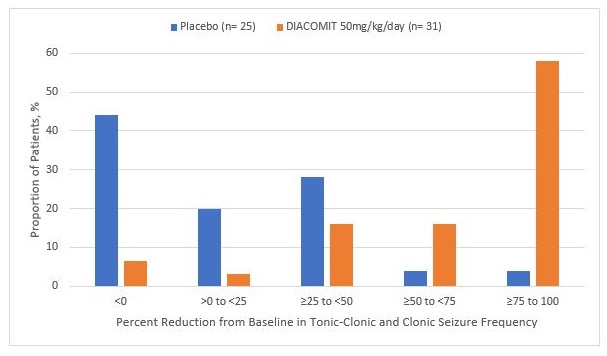
The effectiveness of DIACOMIT for the treatment of seizures associated with Dravet syndrome in patients 6 months of age to less than 3 years of age was extrapolated from the demonstration of effectiveness in patients 3 years to less than 18 years of age in Study 1 and Study 2.
-
16 HOW SUPPLIED/STORAGE AND HANDLING
16.1 How Supplied
DIACOMIT Capsules
- 250 mg: size 2, pink, and imprinted with “Diacomit” and “250mg” are supplied as follows:
Bottles of 60 NDC 68418-7939-6 - 500 mg: size 0, white, and imprinted with “Diacomit” and “500mg” are supplied as follows:
Bottles of 60 NDC 68418-7940-6
For Oral Suspension
- 250 mg: pale pink fruit flavored powder packaged in packets are supplied as follows:
Cartons of 60 NDC 68418-7941-6 - 500 mg: pale pink fruit flavored powder packaged in packets are supplied as follows:
Cartons of 60 NDC 68418-7942-6
- 250 mg: size 2, pink, and imprinted with “Diacomit” and “250mg” are supplied as follows:
-
17 PATIENT COUNSELING INFORMATION
Advise the patient to read the FDA-approved patient labeling (Medication Guide and Instructions for Use).
DIACOMIT Oral Capsule Administration
Inform patients or caregivers that DIACOMIT capsules must be swallowed whole with a glass of water during a meal. Capsules should not be broken or opened.DIACOMIT For Oral Suspension Administration
DIACOMIT should be mixed in a glass of water and should be taken immediately after mixing during a meal [see Instructions for Use].Somnolence
Advise patient or caregivers that somnolence may occur, and may require a decrease in the dose of clobazam [see Warnings and Precautions (5.1)]. Also, advise the patients and their caregivers to avoid alcohol consumption during DIACOMIT treatment [see Drug Interactions (7.3)].
If applicable, caution patients about hazardous machinery, including automobiles, until they know how DIACOMIT affects them.
Decreased Appetite and Decreased Weight
Advise patients or caregivers that decreased appetite is frequent and nausea and vomiting can also occur during DIACOMIT treatment, which can cause loss of weight [see Warnings and Precautions (5.2)].Withdrawal Symptoms
Advise patients or caregivers that abrupt withdrawal of DIACOMIT may increase their risk of seizures or status epilepticus [see Dosage and Administration (2.5) and Warnings and Precautions (5.4)]. Instruct patients or caregivers to not discontinue use of DIACOMIT without consulting with their healthcare provider.Neutropenia and Thrombocytopenia
Advise patients or caregivers of the risk of neutropenia and thrombocytopenia and the importance of hematologic testing, which should be obtained prior to starting treatment with DIACOMIT and then every 6 months [see Warnings and Precautions (5.3)].
Suicidal Thinking and Behavior
Counsel patients, their caregivers, and their families that AEDs, including DIACOMIT, may increase the risk of suicidal thoughts and behavior and advise them of the need to be alert for the emergence of worsening of symptoms of depression, any unusual changes in mood or behavior, or the emergence of suicidal thoughts, behavior, or thought of self-harm. Patients or caregivers should report behaviors of concern immediately to healthcare providers [see Warnings and Precautions (5.5)].Use in Pregnancy
Advise patients to notify their healthcare provider if they become pregnant or intend to become pregnant during DIACOMIT therapy. Encourage patients to enroll in the NAAED Pregnancy registry if they become pregnant. This registry is collecting information about the safety of AEDs during pregnancy [see Use in Specific Populations (8.1)].Use in Nursing
Instruct patients to notify their physician if they are breast feeding or intend to breast feed during therapy [see Use in Specific Populations (8.2)].DIACOMIT Capsules and DIACOMIT for Oral Suspension manufactured by:
BIOCODEX
1, avenue Blaise Pascal
60000 BEAUVAIS
France -
MEDICATION GUIDE
Medication Guide has been approved by the U.S. Food and Drug Administration Issued: 07/2022 MEDICATION GUIDE
DIACOMIT (die-uh-KA-mit)
(stiripentol)
capsules, for oral use
for oral suspension
Read this Medication Guide before you start taking DIACOMIT and each time you get a refill. There may be new information.
This information does not take the place of talking to your healthcare provider about your medical condition or treatment.What is the most important information I should know about DIACOMIT?
DIACOMIT can cause serious side effects, including:- Sleepiness and drowsiness. Sleepiness and drowsiness are serious and common side effects. DIACOMIT can make you sleepy or dizzy, and slow your thinking. Your healthcare provider may decrease your dose of clobazam or other seizure medicines.
- Do not drive, operate heavy machinery, or do other dangerous activities until you know how DIACOMIT affects you.
- Do not drink alcohol or take other medicines that may make you sleepy or dizzy while taking DIACOMIT until you talk to your healthcare provider.
- DIACOMIT, when taken with alcohol or medicines that cause sleepiness or dizziness, may make your sleepiness or dizziness worse.
- Loss of appetite and weight loss. Loss of appetite and weight loss are serious and common side effects. DIACOMIT can cause frequent nausea and loss of appetite that can cause weight loss.
- Your weight should be checked frequently during DIACOMIT treatment.
- Children who take DIACOMIT should have their weight and growth checked often.
- Low white blood cell counts (neutropenia) and low platelet counts (thrombocytopenia). Low white blood cell counts may occur during treatment with DIACOMIT and may cause serious infections. Low platelet counts may cause serious bleeding problems. Your healthcare provider should check your white blood cell count and platelet count before and during treatment.
- Do not stop taking DIACOMIT without first talking to your healthcare provider. Stopping a seizure medicine such as DIACOMIT should be done slowly to avoid having seizures more often, or seizures that do not stop (status epilepticus).
- Like other antiepileptic drugs, DIACOMIT may cause suicidal thoughts or actions in a very small number of people (about 1 in 500).
Call your healthcare provider right away if you have any of these symptoms, especially if they are new, worse, or worry you:- thoughts about suicide or dying
- attempts to commit suicide
- new or worse depression
- new or worse anxiety
- feeling agitated or restless
- panic attacks
- trouble sleeping (insomnia)
- new or worse irritability
- acting aggressive, being angry, or violent
- acting on dangerous impulses
- an extreme increase in activity and talking (mania)
- other unusual changes in behavior or mood
- Pay attention to any changes, especially sudden changes, in mood, behaviors, thoughts, or feelings.
- Keep all follow-up visits with your healthcare provider as scheduled.
Suicidal thoughts or actions can be caused by things other than medicines. If you have suicidal thoughts or actions, your healthcare provider may check for other causes.
Call your healthcare provider right away if you have any of the above side effects while taking DIACOMIT.What is DIACOMIT?
DIACOMIT is a prescription medicine used along with clobazam to treat seizures in people with Dravet syndrome who are 6 months of age and older and weighing 15 pounds (7 kg) or more.
DIACOMIT has not been shown to be able to treat seizures associated with Dravet syndrome without the use of clobazam.
It is not known if DIACOMIT is safe and effective in children under 6 months of age or who weigh less than 15 pounds (7 kg).Before you take DIACOMIT, tell your healthcare provider about all of your medical conditions, including if you: - have liver or kidney problems.
- have phenylkentonuria (PKU). DIACOMIT for oral suspension contains aspartame. The artificial sweetener may be harmful to people with PKU.
- have or have had depression, mood problems, suicidal thoughts or behavior.
- drink alcohol.
- are pregnant or plan to become pregnant. It is not known if DIACOMIT may harm your unborn baby.
- Tell your healthcare provider right away if you become pregnant while taking DIACOMIT. You and your healthcare provider will decide if you should take DIACOMIT while you are pregnant.
- Pregnancy Registry: If you become pregnant while taking DIACOMIT, talk to your healthcare provider about registering with the North American Antiepileptic Drug Pregnancy Registry. You can register by calling 1-888-233-2334. The purpose of this registry is to collect information about the safety of antiepileptic medicines, including DIACOMIT, during pregnancy. Information about the registry can be found at the website, http://www.aedpregnancyregistry.org/.
- are breastfeeding, or plan to breastfeed. It is not known if DIACOMIT passes into breast milk. Talk to your healthcare provider about the best way to feed your baby while taking DIACOMIT.
Taking DIACOMIT with certain other medicines can cause side effects or affect how well DIACOMIT or the other medicines work. Do not start or stop other medicines without talking to your healthcare provider. Know the medicines you take. Keep a list of them and show it to your healthcare provider and pharmacist when you get a new medicine.How should I take DIACOMIT? - Take DIACOMIT exactly as your healthcare provider tells you to take it.
- Your healthcare provider will tell you how much DIACOMIT to take and when to take it.
- DIACOMIT capsules should be swallowed whole with a glass of water during a meal. Do not break or open capsules.
- DIACOMIT for oral suspension should be mixed in a glass of water (100 mL) and should be taken right away after mixing during a meal. To be sure there is no medicine left in the glass, add a small amount of water (25 mL) to the drinking cup and drink all of the mixture. See the complete Instructions for Use on the right way to use DIACOMIT for oral suspension.
- Your healthcare provider may change your dose if needed. Do not change your dose of DIACOMIT without talking to your healthcare provider.
- If you miss a dose of DIACOMIT, take it as soon as you remember. If it is almost time for the next scheduled dose, skip the missed dose and take your next dose at your regular time. Do not take 2 doses of DIACOMIT at the same time.
- If you take too much DIACOMIT, call your healthcare provider or go to the nearest hospital emergency room right away.
What should I avoid while taking DIACOMIT? - Do not drive, operate heavy machinery, or do other dangerous activities that need you to be alert until you know how DIACOMIT affects you.
- Do not drink alcohol or take other medicines that may make you sleepy or dizzy while taking DIACOMIT without first talking to your healthcare provider.
What are the possible side effects of DIACOMIT?
DIACOMIT may cause serious side effects, including:- See “What is the most important information I should know about DIACOMIT?”
- agitation
- loss of control of body movements (ataxia)
- low muscle tone or muscle weakness (hypotonia)
- nausea
- tremor
- trouble saying words clearly (dysarthria)
- trouble sleeping (insomnia)
Tell your healthcare provider if you have any side effect that bothers you or that does not go away.
Call your doctor for medical advice about side effects. You may report side effects to FDA at 1-800-FDA-1088.How should I store DIACOMIT? - Store DIACOMIT at room temperature between 68°F to 77°F (20°C to 25°C).
- Store in a dry place in the original package.
- Protect from light.
General information about the safe and effective use of DIACOMIT.
Medicines are sometimes prescribed for purposes other than those listed in a Medication Guide. Do not use DIACOMIT for a condition for which it was not prescribed. Do not give DIACOMIT to other people, even if they have the same symptoms that you have. It may harm them. You can ask your pharmacist or healthcare provider for information about DIACOMIT that is written for health professionals.What are the ingredients in DIACOMIT?
Active ingredient: stiripentol
Capsule inactive ingredients: erythrosine (250 mg capsule only), gelatin, indigotine (250 mg capsule only), magnesium stearate, povidone, sodium starch glycolate, titanium dioxide.For oral suspension inactive ingredients: aspartame, carmellose sodium, erythrosine, glucose, hydroxyethylcellulose, povidone, sodium starch glycolate, sorbitol, titanium dioxide, tutti frutti flavor.
Manufactured by:
BIOCODEX, 1 avenue Blaise Pascal, 60000 BEAUVAIS – France
For more information about DIACOMIT, go to www.biocodex.com or call BIOCODEX at 1-866-330-3050 - Sleepiness and drowsiness. Sleepiness and drowsiness are serious and common side effects. DIACOMIT can make you sleepy or dizzy, and slow your thinking. Your healthcare provider may decrease your dose of clobazam or other seizure medicines.
-
INSTRUCTIONS FOR USE
INSTRUCTIONS FOR USE
DIACOMIT (die-uh-KA-mit)
(stiripentol)
for oral suspensionBe sure that you read, understand, and follow the Instructions for Use before preparing your child’s first dose of DIACOMIT for oral suspension and each time you get a refill. There may be new information. This information does not take the place of talking to your child’s healthcare provider about their medical condition or treatment. Ask your child’s healthcare provider or pharmacist if you have questions about how to mix or give a dose of DIACOMIT for oral suspension.
Important information:
- Your child’s healthcare provider will tell you the dose of DIACOMIT and how many packets are needed for your child’s dose.
- Each packet of DIACOMIT for oral suspension contains 250 mg or 500 mg of DIACOMIT as a powder. Be sure to use the right strength to prepare your child’s dose.
- When you receive DIACOMIT for oral suspension prescription at the pharmacy, check to make sure that you were given the right strength of DIACOMIT for oral suspension, the carton is not damaged, and the packets are not opened.
- Make sure you have enough packets of DIACOMIT for oral suspension to give a full dose. Call your healthcare provider if you need more DIACOMIT for oral suspension. Do not run out of your child’s medicine.
- Check that the expiration date on the carton (located on the bottom of the carton) and packet (located at the bottom right of the back side of the packet) has not passed. Do not use if the expiration date has passed.
- Talk with your child’s healthcare provider to help decide the best schedule for giving your child DIACOMIT for oral suspension.
- DIACOMIT for oral suspension must be mixed with water and your child must eat food right after taking DIACOMIT for oral suspension.
- Be sure to give the entire prepared dose of DIACOMIT for oral suspension to your child.
- For more information about DIACOMIT for oral suspension, see the “Medication Guide.”
Instructions for mixing DIACOMIT for oral suspension:
- Before you prepare a dose of DIACOMIT for oral suspension, check the prescription label on the carton for the number of packets you need to prepare a dose.
- Take the prescribed number of packets of DIACOMIT for oral suspension needed for the prescribed dose out of the carton.
- Wash and dry your hands before and after preparing DIACOMIT for oral suspension.
- When preparing DIACOMIT for oral suspension, choose a clean, flat work surface, and place the supplies you will need on the work surface.
Gather the following supplies:
- 1-spoon
- 1-measuring cup
- 1-small drinking cup
- water
- the correct number of DIACOMIT for oral suspension packets needed for the prescribed dose
- 1-clean pair of scissors
Step 1. Fill measuring cup with 100 mL of water.
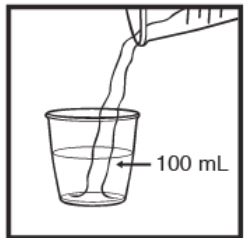
Step 2. Pour 100 mL of water into the small drinking cup.
Step 3. Tap the packet of DIACOMIT for oral suspension to settle the medicine to the bottom of the packet.

Step 4. Using a clean pair of scissors, cut off the top of the packet and make sure the packet is fully open.
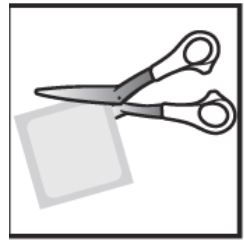
Step 5. Empty the packet into the small drinking cup.
- Look inside the packet to make sure there is no medicine left inside.
- If there is medicine left inside, hold the open end of the packet over your small drinking cup and tap the packet again to get all of the medicine out.
To make sure a full dose of DIACOMIT for oral suspension is given, it is important not to spill any medicine and that there is no medicine left in the packet.

Repeat Steps 3 through 5 for each packet of DIACOMIT for oral suspension needed for the total prescribed dose.
Step 6. Hold the small drinking cup with one hand. With your other hand, use the spoon to gently mix the medicine and the water until clear.
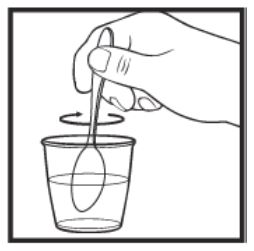
Steps 7 and 8 must be completed right after mixing the medicine.
Step 7. Have your child drink all of the mixture in the small drinking cup.
Step 8. To make sure there is no mixture left in the small drinking cup, add a small amount (25 mL) of water to the small drinking cup:
- Stir with the spoon.
- Repeat Step 7 above.
Step 9. Wash the small drinking cup and spoon. Allow the small drinking cup and spoon to dry. Throw away the empty packet and clean the work surface.
How should I store DIACOMIT for oral suspension?
- Store DIACOMIT for oral suspension at room temperature between 68°F to 77°F (20°C to 25°C).
- Store in the original package to protect from light.
- Do not open DIACOMIT for oral suspension packet until ready to use.
- Do not store the DIACOMIT mixture after it is mixed. It must be taken right after mixing.
Keep DIACOMIT for oral suspension and all medicines out of the reach of children.
This Instructions for Use has been approved by the U.S. Food and Drug Administration.
Manufactured by:
BIOCODEX, 1 avenue Blaise Pascal, 60000 BEAUVAIS – FranceApproved: 7/2022
-
PACKAGE LABEL
NDC 68418-7939-6
DIACOMIT® 250 mg
(stiripentol)
Capsule
Attention Pharmacist: Dispense the enclosed Medication Guide to each patient
60 capsules
Rx Only
BIOCODEX
Active ingredient: Each capsule contains 250 mg stiripentol.
Directions for use: Swallow whole with a glass of water during a meal. DO NOT open, break or chew capsules. See full prescribing information for dosage and administration.
Warnings: Please refer to full prescribing information for further information.
Store at 20 to 25ºC (68 to 77ºF) in a dry place. Store in original package to protect from light. Keep out of the reach and sight of children.
*All trademark rights used under license
Manufactured by:
Biocodex, Gentilly, France
Distributed by:
Biocodex, Inc.
San Mateo, CA 94404 USA

NDC 68418-7939-6
DIACOMIT® 250 mg
(stiripentol)
Capsule
Attention Pharmacist: Dispense the enclosed Medication Guide to each patient
60 capsules
BIOCODEX
Rx Only
NDC 68418-7939-6
DIACOMIT® 250 mg
(stiripentol)
Capsule
Attention Pharmacist: Dispense the enclosed Medication Guide to each patient
60 capsules
BIOCODEX
Rx Only
Peel here
Active ingredient: Each capsule contains 250 mg stiripentol.
Directions for use: Swallow whole with a glass of water during a meal. DO NOT open, break or chew capsules.
See full prescribing information for dosage and administration.
Warnings: Please refer to full prescribing information for further information.
Store at 20 to 25ºC (68 to 77ºF) in a dry place.
Store in original package to protect from light.
Keep out of the reach and sight of children.
Manufactured by:
Biocodex, Gentilly, France
Distributed by:
Biocodex, Inc.
San Mateo, CA 94404 USA
*All trademark rights used under license

NDC 68418-7940-6
DIACOMIT® 500 mg
(stiripentol)
Capsule
Attention Pharmacist: Dispense the enclosed Medication Guide to each patient
60 capsules
Rx Only
BIOCODEX
Active ingredient: Each capsule contains 500 mg stiripentol.
Directions for use: Swallow whole with a glass of water during a meal. DO NOT open, break or chew capsules. See full prescribing information for dosage and administration.
Warnings: Please refer to full prescribing information for further information.
Store at 20 to 25ºC (68 to 77ºF) in a dry place. Store in original package to protect from light. Keep out of the reach and sight of children.
*All trademark rights used under license
Manufactured by:
Biocodex, Gentilly, France
Distributed by:
Biocodex, Inc.
San Mateo, CA 94404 USA

NDC 68418-7940-6
DIACOMIT® 500 mg
(stiripentol)
Capsule
Attention Pharmacist: Dispense the enclosed Medication Guide to each patient
60 capsules
BIOCODEX
Rx Only
NDC 68418-7940-6
DIACOMIT® 500 mg
(stiripentol)
Capsule
Attention Pharmacist: Dispense the enclosed Medication Guide to each patient
60 capsules
BIOCODEX
Rx Only
Peel here
Active ingredient: Each capsule contains 500 mg stiripentol.
Directions for use: Swallow whole with a glass of water during a meal. DO NOT open, break or chew capsules.
See full prescribing information for dosage and administration.
Warnings: Please refer to full prescribing information for further information.
Store at 20 to 25ºC (68 to 77ºF) in a dry place.
Store in original package to protect from light.
Keep out of the reach and sight of children.
Manufactured by:
Biocodex, Gentilly, France
Distributed by:
Biocodex, Inc.
San Mateo, CA 94404 USA
*All trademark rights used under license

NDC 68418-7941-6
DIACOMIT®
250 mg/packet
(stiripentol)
For oral suspension
Attention Pharmacist: Dispense the enclosed Medication Guide to each patient
60 Packets
Rx Only
BIOCODEX
Active ingredient: Each packet contains 250 mg stiripentol.
PHENYLKETONURICS: CONTAINS PHENYLALANINE - KEEP THIS AND ALL DRUGS OUT OF REACH OF CHILDREN.
Preparation: The powder should be mixed in a glass of water and should be taken immediately after mixing during a meal. See full prescribing information for dosage and administration.
Warnings: Please refer to full prescribing information for further information.
Store at 20 to 25ºC (68 to 77ºF) in a dry place. Store in original package to protect from light. Keep out of the reach and sight of children.
*All trademark rights used under license
Manufactured by:
Biocodex, Gentilly, France
Distributed by:
Biocodex, Inc.
San Mateo, CA 94404 USA
30860/04

NDC 68418-7941-6
DIACOMIT®
250 mg/packet
(stiripentol)
For oral suspension
Rx Only
BIOCODEX
See accompanying prescribing information for complete dosage and administration information. This packet contains 250 mg of stiripentol.
PHENYLKETONURICS: CONTAINS PHENYLALANINE - KEEP THIS AND ALL DRUGS OUT OF REACH OF CHILDREN - This packet is not child-resistant.
Preparation: The powder should be mixed in a glass of water and should be taken immediately after mixing during a meal.
*All trademark rights used under license
Store at 20 to 25ºC (68 to 77ºF)
Manufactured by Biocodex France
Lot:
EXP:
5560/03
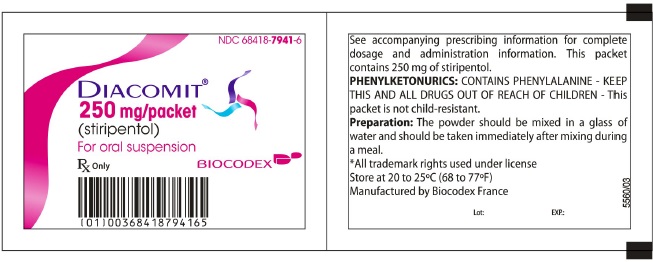
NDC 68418-7942-6
DIACOMIT®
500 mg/packet
(stiripentol)
For oral suspension
Attention Pharmacist: Dispense the enclosed Medication Guide to each patient
60 Packets
Rx Only
BIOCODEX
Active ingredient: Each packet contains 500 mg stiripentol.
PHENYLKETONURICS: CONTAINS PHENYLALANINE - KEEP THIS AND ALL DRUGS OUT OF REACH OF CHILDREN.
Preparation: The powder should be mixed in a glass of water and should be taken immediately after mixing during a meal. See full prescribing information for dosage and administration.
Warnings: Please refer to full prescribing information for further information.
Store at 20 to 25ºC (68 to 77ºF) in a dry place. Store in original package to protect from light. Keep out of the reach and sight of children.
*All trademark rights used under license
Manufactured by:
Biocodex, Gentilly, France
Distributed by:
Biocodex, Inc.
San Mateo, CA 94404 USA
30870/04
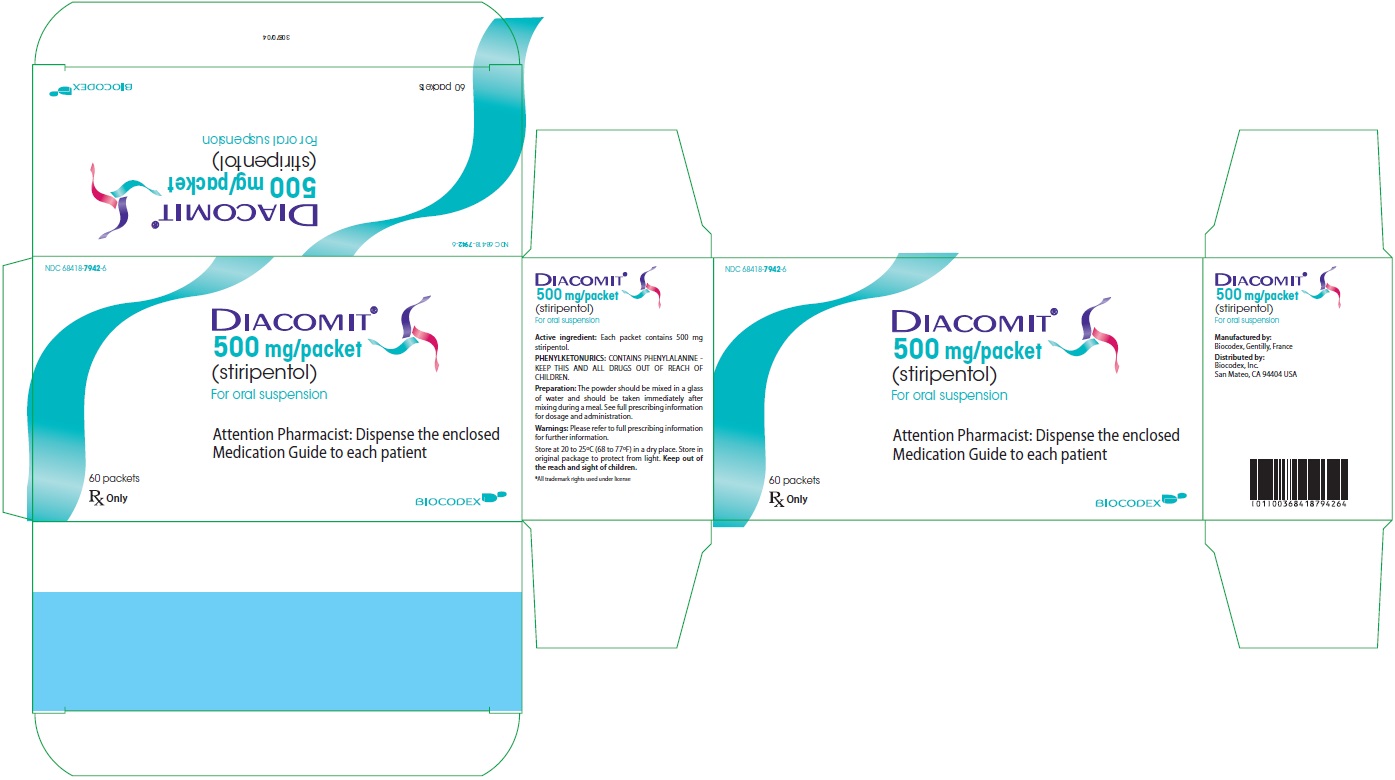
NDC 68418-7942-6
DIACOMIT®
500 mg/packet
(stiripentol)
For oral suspension
Rx Only
BIOCODEX
See accompanying prescribing information for complete dosage and administration information. This packet contains 250 mg of stiripentol.
PHENYLKETONURICS: CONTAINS PHENYLALANINE - KEEP THIS AND ALL DRUGS OUT OF REACH OF CHILDREN - This packet is not child-resistant.
Preparation: The powder should be mixed in a glass of water and should be taken immediately after mixing during a meal.
*All trademark rights used under license
Store at 20 to 25ºC (68 to 77ºF)
Manufactured by Biocodex France
Lot:
EXP:
5570/03
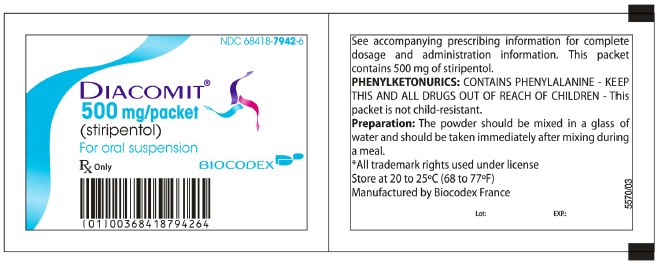
-
INGREDIENTS AND APPEARANCE
DIACOMIT
stiripentol capsuleProduct Information Product Type HUMAN PRESCRIPTION DRUG Item Code (Source) NDC:68418-7939 Route of Administration ORAL Active Ingredient/Active Moiety Ingredient Name Basis of Strength Strength Stiripentol (UNII: R02XOT8V8I) (Stiripentol - UNII:R02XOT8V8I) Stiripentol 250 mg Inactive Ingredients Ingredient Name Strength FD&C Red No. 3 (UNII: PN2ZH5LOQY) Gelatin, Unspecified (UNII: 2G86QN327L) FD&C Blue No. 2 (UNII: L06K8R7DQK) Magnesium Stearate (UNII: 70097M6I30) Povidone (UNII: FZ989GH94E) Sodium Starch Glycolate Type A Potato (UNII: 5856J3G2A2) Titanium Dioxide (UNII: 15FIX9V2JP) Product Characteristics Color PINK Score no score Shape CAPSULE Size 15mm Flavor Imprint Code Diacomit;250mg Contains Packaging # Item Code Package Description Marketing Start Date Marketing End Date 1 NDC:68418-7939-6 1 in 1 CARTON 08/21/2018 1 60 in 1 BOTTLE; Type 0: Not a Combination Product Marketing Information Marketing Category Application Number or Monograph Citation Marketing Start Date Marketing End Date NDA NDA206709 08/21/2018 DIACOMIT
stiripentol capsuleProduct Information Product Type HUMAN PRESCRIPTION DRUG Item Code (Source) NDC:68418-7940 Route of Administration ORAL Active Ingredient/Active Moiety Ingredient Name Basis of Strength Strength Stiripentol (UNII: R02XOT8V8I) (Stiripentol - UNII:R02XOT8V8I) Stiripentol 500 mg Inactive Ingredients Ingredient Name Strength Gelatin, Unspecified (UNII: 2G86QN327L) Magnesium Stearate (UNII: 70097M6I30) Povidone (UNII: FZ989GH94E) Sodium Starch Glycolate Type A Potato (UNII: 5856J3G2A2) Titanium Dioxide (UNII: 15FIX9V2JP) Product Characteristics Color white Score no score Shape CAPSULE Size 18mm Flavor Imprint Code Diacomit;500mg Contains Packaging # Item Code Package Description Marketing Start Date Marketing End Date 1 NDC:68418-7940-6 1 in 1 CARTON 08/21/2018 1 60 in 1 BOTTLE; Type 0: Not a Combination Product Marketing Information Marketing Category Application Number or Monograph Citation Marketing Start Date Marketing End Date NDA NDA206709 08/21/2018 DIACOMIT
stiripentol powder, for suspensionProduct Information Product Type HUMAN PRESCRIPTION DRUG Item Code (Source) NDC:68418-7941 Route of Administration ORAL Active Ingredient/Active Moiety Ingredient Name Basis of Strength Strength Stiripentol (UNII: R02XOT8V8I) (Stiripentol - UNII:R02XOT8V8I) Stiripentol 250 mg Inactive Ingredients Ingredient Name Strength Aspartame (UNII: Z0H242BBR1) Carboxymethylcellulose Sodium, Unspecified Form (UNII: K679OBS311) FD&C Red No. 3 (UNII: PN2ZH5LOQY) Dextrose, Unspecified Form (UNII: IY9XDZ35W2) Hydroxyethyl Cellulose (2000 Mpa.S At 1%) (UNII: S38J6RZN16) Povidone (UNII: FZ989GH94E) Sodium Starch Glycolate Type A Potato (UNII: 5856J3G2A2) Sorbitol (UNII: 506T60A25R) Titanium Dioxide (UNII: 15FIX9V2JP) Acacia (UNII: 5C5403N26O) Bergamot Oil (UNII: 39W1PKE3JI) Hypromelloses (UNII: 3NXW29V3WO) Maltodextrin (UNII: 7CVR7L4A2D) Vanillin (UNII: CHI530446X) Product Characteristics Color PINK Score Shape Size Flavor TUTTI FRUTTI Imprint Code Contains Packaging # Item Code Package Description Marketing Start Date Marketing End Date 1 NDC:68418-7941-6 60 in 1 CARTON 08/21/2018 1 1 in 1 PACKET; Type 0: Not a Combination Product Marketing Information Marketing Category Application Number or Monograph Citation Marketing Start Date Marketing End Date NDA NDA207223 08/21/2018 DIACOMIT
stiripentol powder, for suspensionProduct Information Product Type HUMAN PRESCRIPTION DRUG Item Code (Source) NDC:68418-7942 Route of Administration ORAL Active Ingredient/Active Moiety Ingredient Name Basis of Strength Strength Stiripentol (UNII: R02XOT8V8I) (Stiripentol - UNII:R02XOT8V8I) Stiripentol 500 mg Inactive Ingredients Ingredient Name Strength Aspartame (UNII: Z0H242BBR1) Carboxymethylcellulose Sodium, Unspecified Form (UNII: K679OBS311) FD&C Red No. 3 (UNII: PN2ZH5LOQY) Dextrose, Unspecified Form (UNII: IY9XDZ35W2) Hydroxyethyl Cellulose (2000 Mpa.S At 1%) (UNII: S38J6RZN16) Povidone (UNII: FZ989GH94E) Sodium Starch Glycolate Type A Potato (UNII: 5856J3G2A2) Sorbitol (UNII: 506T60A25R) Titanium Dioxide (UNII: 15FIX9V2JP) Acacia (UNII: 5C5403N26O) Bergamot Oil (UNII: 39W1PKE3JI) Hypromelloses (UNII: 3NXW29V3WO) Maltodextrin (UNII: 7CVR7L4A2D) Vanillin (UNII: CHI530446X) Product Characteristics Color PINK Score Shape Size Flavor TUTTI FRUTTI Imprint Code Contains Packaging # Item Code Package Description Marketing Start Date Marketing End Date 1 NDC:68418-7942-6 60 in 1 CARTON 08/21/2018 1 1 in 1 PACKET; Type 0: Not a Combination Product Marketing Information Marketing Category Application Number or Monograph Citation Marketing Start Date Marketing End Date NDA NDA207223 08/21/2018 Labeler - BIOCODEX, INC. (792454464) Establishment Name Address ID/FEI Business Operations BIOCODEX 394954077 manufacture(68418-7939, 68418-7940, 68418-7941, 68418-7942)

